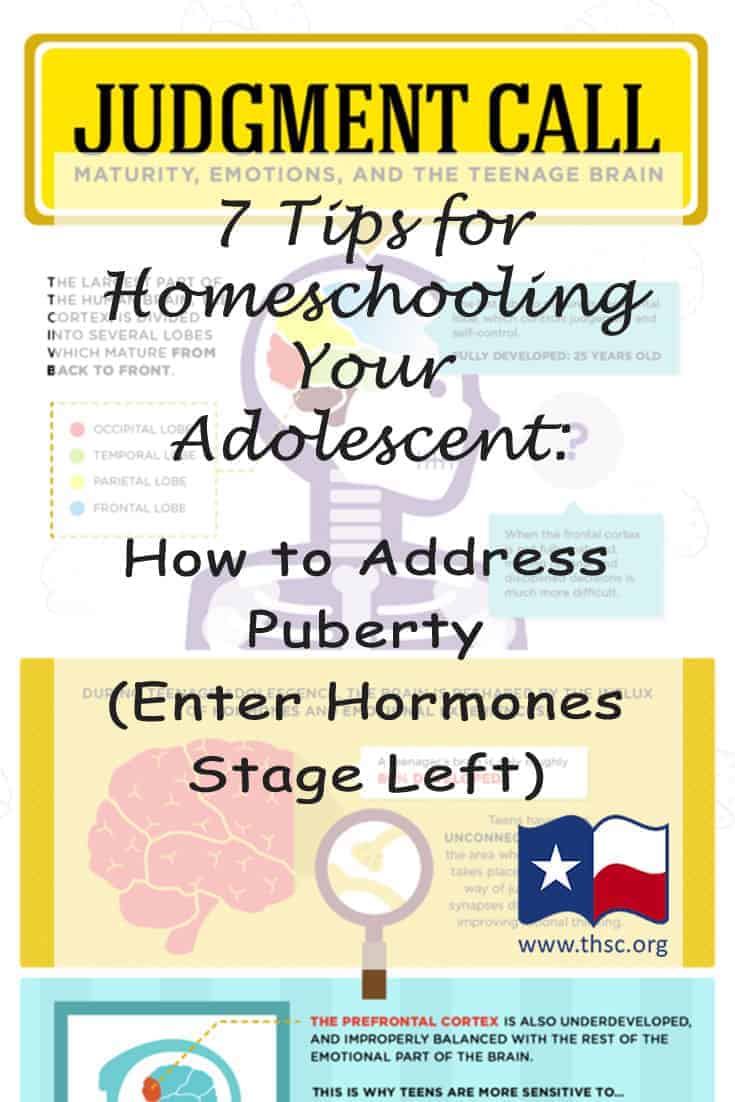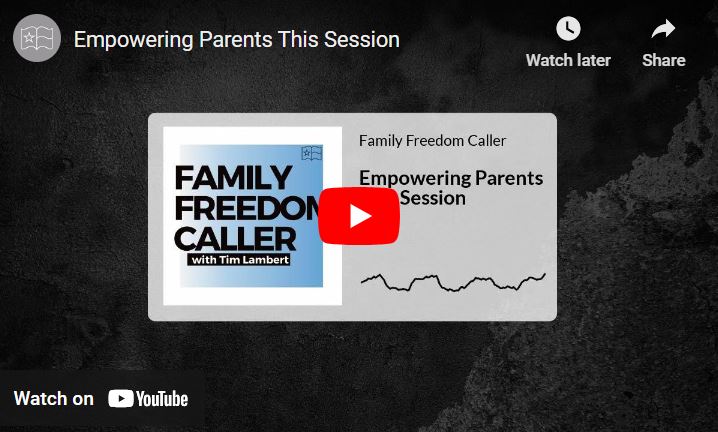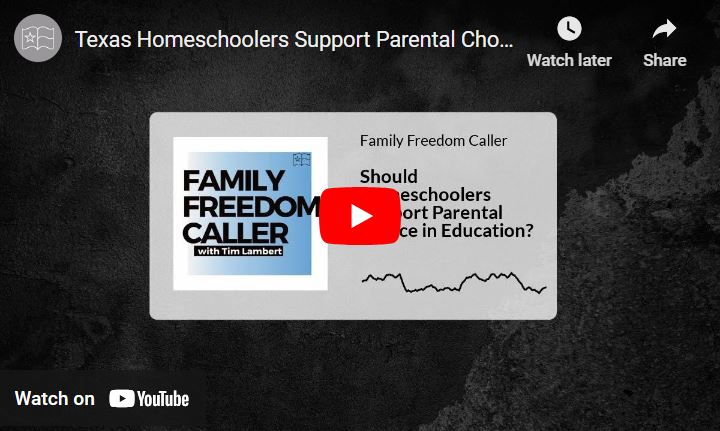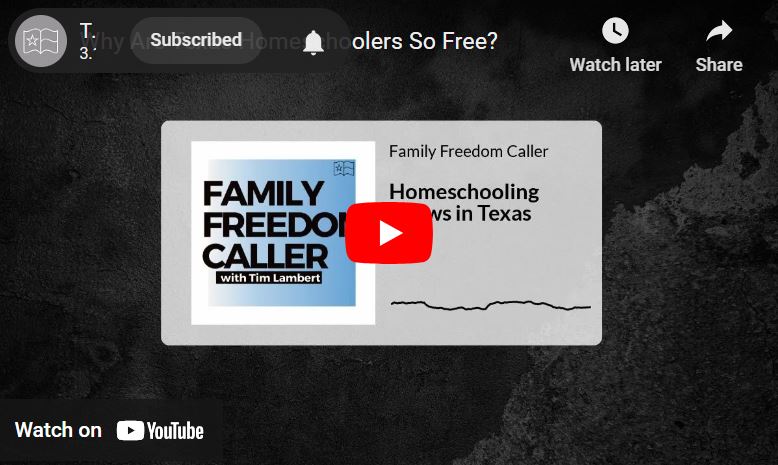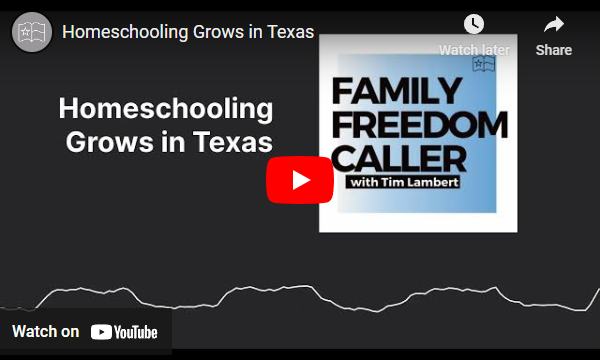By LeeAnn Garfias and Louise Butler
Only once in all the time I have been homeschooling have I seriously wanted to put my adolescent child on the bus and send him off to school. And I blame hormones. Not mine—his!
The hormones of puberty transformed my smart, respectful, hard-working, obedient son into a back-talking, lazy, negligent adolescent who barely passed his assignments after repeated nagging and cross words!
During those months, I counted the minutes until my husband came home as if I were babysitting quintuplets. The constant power struggles, the bad attitudes, the needless arguing, and the smell—that awful smell! In despair, I pleaded with my husband to let me turn the boy out of the house and onto the school bus. Have mercy, man! This mom’s had all she can take!
Spoiler alert: my husband did not let me put him on the bus—and now the boy is a homeschool graduate. But, it was touch and go for a few years until the curtain came down on that drama. I applauded in blissful ignorance, but this was not a one-act play.
The curtain soon went up again, this time starring my daughter. Then, it was Act Three—my second son!
It’s from the sweet intermission before the final act starring my fourth child that I offer these seven tips for not getting too caught up in the drama of puberty when homeschooling your adolescent.
1. Mom and Dad Should Co-Direct During the Adolescent Stage
Yes, I was the one “stuck in the house all day” homeschooling my adolescents (and their younger siblings), so I bore the brunt of the struggle. However, my husband and I maintained a united front.
Dad took on more and more of the discipline, coaching the preteens about his expectations before he left for work each day. When he returned home at night, he held them accountable for finishing their school work and chores.
My husband’s increased involvement with the older students allowed me to step back from micromanaging their tasks, which greatly eased tensions during the day.
2. Help Your Teens Learn Their Lines
The preteen years are difficult for young people. The emotions, changes, and struggles are so new, so I tried giving them labels for what was going on:
- Are you feeling frustrated all of a sudden?
- Sometimes at your age, I felt angry for no reason. Does that happen to you?
- Are you tired? Would you like to take a break now?
- Do your siblings annoy you at times?
I showed my daughter how to track her monthly cycle and encouraged her to simply tell her brothers, “This is a bad week for me; please don’t tease me for a few days,” when she felt overwhelmed.
Soon the preteens learned to speak up when their emotions were overpowering, and the entire family appreciated the heads-up.
3. Increase the Level of Activity During Puberty
We gave our adolescents plenty of outlets for their energy. The preteen years send vast emotions along with bursts of physical energy that can often result in the whim-whams, fidgets, and unintentional property damage.
To make things easier for everyone, I tried to give them physical tasks, hard work, and exercise. After mowing the lawn, running a couple of miles, or playing a rousing game of four-square, my young people felt happier and calmer. Their grades improved, too!
4. Role Model the Toughest Parts of Physical Changes
The hardest lesson of the preteen years is control–controlling body, emotions, and words, no matter how your adolescent feels.
That’s hard for adults, too, so this stage was a reminder to humbly apologize for my own outbursts.
We all get tired and cranky, and everyone overreacts from time to time. Apologizing quickly and sincerely goes a long way.
5. Tone Down the Intense Scenes When Homeschooling Your Adolescent
When preteens begin to think for themselves, arguments ensue. However, disagreement isn’t as problematic when they learn how to respectfully state their opinions.
Young people should learn to think and to speak up for themselves; these are healthy qualities that protect them from abuse, bullying, and false ideas. But, it’s hard for everyone to disagree kindly.
Preteen years offer plenty of rehearsal in respectful disagreement; actually, there are several opportunities each day! When we as parents listen patiently to our preteens and calmly state our own differing opinions, we demonstrate how to discuss differences maturely.
6. Encourage Independence During the Adolescent Stage
Healthy preteens have a growing need to separate from their parents. After all, childhood is about preparing to be an adult.
Our young people are anxious to begin the process by asserting their personalities, opinions, and ideas every chance they can. This separation process can lead to unhealthy and dangerous activities (joining gangs, breaking the law, experimenting with illegal substances, etc.). However, separation in itself is not bad.
My husband and I looked for opportunities that allowed our young people to separate in healthy and age-appropriate ways. We let them work odd jobs for the neighbors without our direct supervision, babysit younger siblings for increasing lengths of time, walk a mile down the road to buy ice cream, play at friends’ homes, and volunteer in community events.
My middle son even took over most of the garage, creating his own personal space by converting it into his man cave with furniture and electronics he purchased from thrift stores with his lawn mowing money!
7. Monitor Who Is Joining Their Peer Group
Each of our preteens began making their own friends and relationships in church and in the community, but we kept an eye on who those new friends were. At this stage in development, peers can seem even more important than family—peer pressure is real and to be reckoned with—so it’s best to intervene quickly, before bonds form, if you have some fear and trembling about new friend choices.
With increased independence, our young people had more opportunities to learn building a reputation, how to work well with others, and how to resolve conflicts outside the family.
As a young mom, I dreaded the preteen years. And when I first encountered these hormones with my oldest son, I was just as overwhelmed as he was. Even though I won’t be calling for an encore homeschooling my adolescent, I thoroughly enjoyed watching the story unroll as God shaped them into the exceptional people He created them to be.
Lea Ann Garfias believes there is enough coffee in the world to make even dreadful Thursdays possible. She helps ordinary moms realize their extraordinary influence in her book, Rocking Ordinary, available on Amazon.com. When she’s not homeschooling her four children, directing her church choir, or playing the violin, she’s passed out asleep. You’ll find evidence of her existence at LaGarfias.com.
***
Help for Talking With Your Children About Puberty:
- Nutrition 101: Choose Life by Growing Healthy Homes (written by homeschool mothers)
- The Care and Keeping of You (an American Girl book)
- Preparing for Adolescence: How to Survive the Coming Years of Change (by Dr. James Dobson)
Under Construction: The Teenage Brain
 There was a time when the seemingly incongruous, manic workings of the young teen brain were tossed off as a “stage.” Now, thanks to the work of magnetic resonance imaging, we are able to see what is happening in that wonderful, confused, hormone-fueled, frenetic teen brain during puberty.
There was a time when the seemingly incongruous, manic workings of the young teen brain were tossed off as a “stage.” Now, thanks to the work of magnetic resonance imaging, we are able to see what is happening in that wonderful, confused, hormone-fueled, frenetic teen brain during puberty.
The main part of the brain—the big part that most people think of when they hear the word “brain”—is the cerebrum. This is the thinking, communicating, and reasoning part of the brain.
The Adolescent Brain Really Is Different
The cerebrum works the same in your teen as in your spouse, but not under the same conditions. Your teen’s brain is doing things that absolutely no adult brain does!
Humans are born with a brain designed to maximize the chance for survival. That means learning. Your brain learns by connecting brain cells along electronic pathways. These pathways are the leap of energy from the dendrites of one cell to the axons of another. As closely packed as our neurons are, the spidery dendrites never actually touch. The space between them is called a synapse, thus the spark from one to another is a synaptic connection.
Our brains are flowing electronic rivers of information. In the first decade of your child’s life, he or she will create trillions of these synaptic connections. That is more than they will ever need.
The Adolescent Brain Goes Through a Major Purging and Reorganization
But, your brain is a greedy organ that will not tolerate energy spent on maintaining little used or inefficient connections. So, between the adolescent ages of 11 and 15, the brain goes through a massive reorganization. It systematically destroys more than 20 percent of all previously built connections!
- The goal is efficiency.
- The method is pruning.
- The result is a poor, confused teenager!
- The collateral damage: frustrated parents.
If you go through each day shaking your head and muttering, “Whatever was that child thinking?,” blame biology. Information that was in one place in the brain one day may not be there the next. It won’t be gone, but the pathway for retrieval may be lost or stolen. The book report may be complete, but its location and the need to turn it in today is buried. If the brain is a file cabinet, theirs has been upended. But, there is help for them and us.
These early teen years during puberty see more physical changes to the body than any time except birth to two years. Remember how much those babies slept? Teenagers need the same thing and for the same reasons. Teens need about 10 hours of sleep each night. They also need extra hydration because the brain uses 30 percent of all the water your child drinks.
Teaching Strategies that Work Better in Adolescence
With all those electronic misfires, their attention span is less than 15 minutes, so direct instruction should come in small doses. They also work best with diversified applications of knowledge:
- Math in social studies
- Art in science
- Music in communication
- Movement in everything
Optimal instruction when homeschooling your adolescent might look something like this:
- Instruct
- Practice the skill presented
- Relate the instruction to another area
- Allow your adolescent to apply the instruction creatively
- Rinse, lather, repeat!
For example, if you are teaching pie charts and percentages in math, teach the direct skill first. Then, have them practice that skill in a workbook. Follow that with instruction on how the pie chart might be used to show other things.
You can introduce an American history lesson and talk about the five presidents serving during a particular era. Then, ask them to compare in pie chart form how influential they think each president was. Next, have your student prepare a written defense of their choice. In this example, math, history, and English all play together, with a little artistic impression thrown in for the pie chart.
Tap Different Parts of the Brain with Interdisciplinary Studies
Also in this example, one skill is used in four disciplines. Mastery depends on the strategy of review. Remember, our teens are destroying old synaptic connections and building more efficient ones. The more you use a synaptic connection the stronger it becomes. The more you access it, the more diversified it becomes. The brain wants to remember!
Review, Review and More Review
One of the best things you can do for your teen’s learning is to give him or her constant but brief doses of review. We know that practice helps musical performance and athletes know that the will to win is useless without the will to prepare. If you want to know math, science, Spanish, or Shakespeare the same is also true.
Review and memorization have long been decried as “old school” or pedantic by the “relevance-based” educational theorists of the ‘70s to ‘90s. It turns out that our grandparents knew from experience what research now knows from analysis: practice makes perfect, especially when homeschooling your adolescent.
Your adolescent’s brain is under construction during puberty, so don your hard hat and start building.
Louise Butler is an award-winning educator with a passion for both the art and science of teaching. In December 1996, Louise Butler made a presentation at the Global Summit on Science and Science Education in which she outlined the four components required of students to beat the Bell Curve and achieve the academic success that they deserve. Her book available on Amazon.com, Beating the Bell Curve, grew out of that presentation.
Are you a THSC member? If not, be sure to sign up to receive more homeschool support and resources. This is how we join together Keeping Texas Families Free!
By LeeAnn Garfias and Louise Butler
Only once in all the time I have been homeschooling have I seriously wanted to put my adolescent child on the bus and send him off to school. And I blame hormones. Not mine—his!
The hormones of puberty transformed my smart, respectful, hard-working, obedient son into a back-talking, lazy, negligent adolescent who barely passed his assignments after repeated nagging and cross words!
During those months, I counted the minutes until my husband came home as if I were babysitting quintuplets. The constant power struggles, the bad attitudes, the needless arguing, and the smell—that awful smell! In despair, I pleaded with my husband to let me turn the boy out of the house and onto the school bus. Have mercy, man! This mom’s had all she can take!
Spoiler alert: my husband did not let me put him on the bus—and now the boy is a homeschool graduate. But, it was touch and go for a few years until the curtain came down on that drama. I applauded in blissful ignorance, but this was not a one-act play.
The curtain soon went up again, this time starring my daughter. Then, it was Act Three—my second son!
It’s from the sweet intermission before the final act starring my fourth child that I offer these seven tips for not getting too caught up in the drama of puberty when homeschooling your adolescent.
1. Mom and Dad Should Co-Direct During the Adolescent Stage
Yes, I was the one “stuck in the house all day” homeschooling my adolescents (and their younger siblings), so I bore the brunt of the struggle. However, my husband and I maintained a united front.
Dad took on more and more of the discipline, coaching the preteens about his expectations before he left for work each day. When he returned home at night, he held them accountable for finishing their school work and chores.
My husband’s increased involvement with the older students allowed me to step back from micromanaging their tasks, which greatly eased tensions during the day.
2. Help Your Teens Learn Their Lines
The preteen years are difficult for young people. The emotions, changes, and struggles are so new, so I tried giving them labels for what was going on:
- Are you feeling frustrated all of a sudden?
- Sometimes at your age, I felt angry for no reason. Does that happen to you?
- Are you tired? Would you like to take a break now?
- Do your siblings annoy you at times?
I showed my daughter how to track her monthly cycle and encouraged her to simply tell her brothers, “This is a bad week for me; please don’t tease me for a few days,” when she felt overwhelmed.
Soon the preteens learned to speak up when their emotions were overpowering, and the entire family appreciated the heads-up.
3. Increase the Level of Activity During Puberty
We gave our adolescents plenty of outlets for their energy. The preteen years send vast emotions along with bursts of physical energy that can often result in the whim-whams, fidgets, and unintentional property damage.
To make things easier for everyone, I tried to give them physical tasks, hard work, and exercise. After mowing the lawn, running a couple of miles, or playing a rousing game of four-square, my young people felt happier and calmer. Their grades improved, too!
4. Role Model the Toughest Parts of Physical Changes
The hardest lesson of the preteen years is control–controlling body, emotions, and words, no matter how your adolescent feels.
That’s hard for adults, too, so this stage was a reminder to humbly apologize for my own outbursts.
We all get tired and cranky, and everyone overreacts from time to time. Apologizing quickly and sincerely goes a long way.
5. Tone Down the Intense Scenes When Homeschooling Your Adolescent
When preteens begin to think for themselves, arguments ensue. However, disagreement isn’t as problematic when they learn how to respectfully state their opinions.
Young people should learn to think and to speak up for themselves; these are healthy qualities that protect them from abuse, bullying, and false ideas. But, it’s hard for everyone to disagree kindly.
Preteen years offer plenty of rehearsal in respectful disagreement; actually, there are several opportunities each day! When we as parents listen patiently to our preteens and calmly state our own differing opinions, we demonstrate how to discuss differences maturely.
6. Encourage Independence During the Adolescent Stage
Healthy preteens have a growing need to separate from their parents. After all, childhood is about preparing to be an adult.
Our young people are anxious to begin the process by asserting their personalities, opinions, and ideas every chance they can. This separation process can lead to unhealthy and dangerous activities (joining gangs, breaking the law, experimenting with illegal substances, etc.). However, separation in itself is not bad.
My husband and I looked for opportunities that allowed our young people to separate in healthy and age-appropriate ways. We let them work odd jobs for the neighbors without our direct supervision, babysit younger siblings for increasing lengths of time, walk a mile down the road to buy ice cream, play at friends’ homes, and volunteer in community events.
My middle son even took over most of the garage, creating his own personal space by converting it into his man cave with furniture and electronics he purchased from thrift stores with his lawn mowing money!
7. Monitor Who Is Joining Their Peer Group
Each of our preteens began making their own friends and relationships in church and in the community, but we kept an eye on who those new friends were. At this stage in development, peers can seem even more important than family—peer pressure is real and to be reckoned with—so it’s best to intervene quickly, before bonds form, if you have some fear and trembling about new friend choices.
With increased independence, our young people had more opportunities to learn building a reputation, how to work well with others, and how to resolve conflicts outside the family.
As a young mom, I dreaded the preteen years. And when I first encountered these hormones with my oldest son, I was just as overwhelmed as he was. Even though I won’t be calling for an encore homeschooling my adolescent, I thoroughly enjoyed watching the story unroll as God shaped them into the exceptional people He created them to be.
Lea Ann Garfias believes there is enough coffee in the world to make even dreadful Thursdays possible. She helps ordinary moms realize their extraordinary influence in her book, Rocking Ordinary, available on Amazon.com. When she’s not homeschooling her four children, directing her church choir, or playing the violin, she’s passed out asleep. You’ll find evidence of her existence at LaGarfias.com.
***
Help for Talking With Your Children About Puberty:
- Nutrition 101: Choose Life by Growing Healthy Homes (written by homeschool mothers)
- The Care and Keeping of You (an American Girl book)
- Preparing for Adolescence: How to Survive the Coming Years of Change (by Dr. James Dobson)
Under Construction: The Teenage Brain
 There was a time when the seemingly incongruous, manic workings of the young teen brain were tossed off as a “stage.” Now, thanks to the work of magnetic resonance imaging, we are able to see what is happening in that wonderful, confused, hormone-fueled, frenetic teen brain during puberty.
There was a time when the seemingly incongruous, manic workings of the young teen brain were tossed off as a “stage.” Now, thanks to the work of magnetic resonance imaging, we are able to see what is happening in that wonderful, confused, hormone-fueled, frenetic teen brain during puberty.
The main part of the brain—the big part that most people think of when they hear the word “brain”—is the cerebrum. This is the thinking, communicating, and reasoning part of the brain.
The Adolescent Brain Really Is Different
The cerebrum works the same in your teen as in your spouse, but not under the same conditions. Your teen’s brain is doing things that absolutely no adult brain does!
Humans are born with a brain designed to maximize the chance for survival. That means learning. Your brain learns by connecting brain cells along electronic pathways. These pathways are the leap of energy from the dendrites of one cell to the axons of another. As closely packed as our neurons are, the spidery dendrites never actually touch. The space between them is called a synapse, thus the spark from one to another is a synaptic connection.
Our brains are flowing electronic rivers of information. In the first decade of your child’s life, he or she will create trillions of these synaptic connections. That is more than they will ever need.
The Adolescent Brain Goes Through a Major Purging and Reorganization
But, your brain is a greedy organ that will not tolerate energy spent on maintaining little used or inefficient connections. So, between the adolescent ages of 11 and 15, the brain goes through a massive reorganization. It systematically destroys more than 20 percent of all previously built connections!
- The goal is efficiency.
- The method is pruning.
- The result is a poor, confused teenager!
- The collateral damage: frustrated parents.
If you go through each day shaking your head and muttering, “Whatever was that child thinking?,” blame biology. Information that was in one place in the brain one day may not be there the next. It won’t be gone, but the pathway for retrieval may be lost or stolen. The book report may be complete, but its location and the need to turn it in today is buried. If the brain is a file cabinet, theirs has been upended. But, there is help for them and us.
These early teen years during puberty see more physical changes to the body than any time except birth to two years. Remember how much those babies slept? Teenagers need the same thing and for the same reasons. Teens need about 10 hours of sleep each night. They also need extra hydration because the brain uses 30 percent of all the water your child drinks.
Teaching Strategies that Work Better in Adolescence
With all those electronic misfires, their attention span is less than 15 minutes, so direct instruction should come in small doses. They also work best with diversified applications of knowledge:
- Math in social studies
- Art in science
- Music in communication
- Movement in everything
Optimal instruction when homeschooling your adolescent might look something like this:
- Instruct
- Practice the skill presented
- Relate the instruction to another area
- Allow your adolescent to apply the instruction creatively
- Rinse, lather, repeat!
For example, if you are teaching pie charts and percentages in math, teach the direct skill first. Then, have them practice that skill in a workbook. Follow that with instruction on how the pie chart might be used to show other things.
You can introduce an American history lesson and talk about the five presidents serving during a particular era. Then, ask them to compare in pie chart form how influential they think each president was. Next, have your student prepare a written defense of their choice. In this example, math, history, and English all play together, with a little artistic impression thrown in for the pie chart.
Tap Different Parts of the Brain with Interdisciplinary Studies
Also in this example, one skill is used in four disciplines. Mastery depends on the strategy of review. Remember, our teens are destroying old synaptic connections and building more efficient ones. The more you use a synaptic connection the stronger it becomes. The more you access it, the more diversified it becomes. The brain wants to remember!
Review, Review and More Review
One of the best things you can do for your teen’s learning is to give him or her constant but brief doses of review. We know that practice helps musical performance and athletes know that the will to win is useless without the will to prepare. If you want to know math, science, Spanish, or Shakespeare the same is also true.
Review and memorization have long been decried as “old school” or pedantic by the “relevance-based” educational theorists of the ‘70s to ‘90s. It turns out that our grandparents knew from experience what research now knows from analysis: practice makes perfect, especially when homeschooling your adolescent.
Your adolescent’s brain is under construction during puberty, so don your hard hat and start building.
Louise Butler is an award-winning educator with a passion for both the art and science of teaching. In December 1996, Louise Butler made a presentation at the Global Summit on Science and Science Education in which she outlined the four components required of students to beat the Bell Curve and achieve the academic success that they deserve. Her book available on Amazon.com, Beating the Bell Curve, grew out of that presentation.
Are you a THSC member? If not, be sure to sign up to receive more homeschool support and resources. This is how we join together Keeping Texas Families Free!


